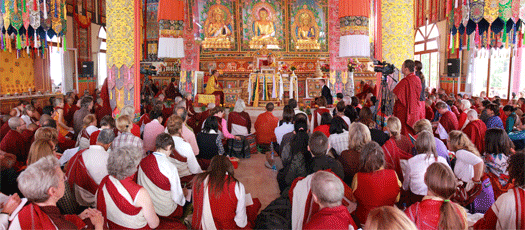28th October – Dorzong Monastery, Gopalpur.
 For the third consecutive day, around a thousand disciples of His Holiness the 17th Karmapa made their way from the surrounding valley and mountainsides back to Dorzong Monastic Institute. Sited on a hilltop and nestled amidst pristine forest as far as the eye can see, the exquisitely painted main shrine hall of Dorzong Institute offers an ideal setting for this historical Dharma transmission by His Holiness on Chöd practice. The skilled hand of the 8th Dru-gu Choegyal Rinpoche, a highly accomplished artist, was everywhere in sight both in the elaborately painted main shrine hall and throughout the institute’s grounds.
For the third consecutive day, around a thousand disciples of His Holiness the 17th Karmapa made their way from the surrounding valley and mountainsides back to Dorzong Monastic Institute. Sited on a hilltop and nestled amidst pristine forest as far as the eye can see, the exquisitely painted main shrine hall of Dorzong Institute offers an ideal setting for this historical Dharma transmission by His Holiness on Chöd practice. The skilled hand of the 8th Dru-gu Choegyal Rinpoche, a highly accomplished artist, was everywhere in sight both in the elaborately painted main shrine hall and throughout the institute’s grounds.
The first topic for today’s session was a history lesson. Recounting key events from the remarkable life of Machig Labdron, the Gyalwang Karmapa stated that Machig Labdron was taught by her mother to read. Gyalwang Karmapa recollected that his own father had made a conscious choice to teach all of his own children to read, including the girls. His family’s valuing of education for girls was anomalous and considered unnecessary according to local values. His Holiness said that his sister—who is now present with him in India and was in fact attending the teaching—also excelled as a young girl at reading Tibetan.
As the Gyalwang Karmapa detailed Machig Labdron’s spiritual accomplishments, he made it clear that hers was a tradition of direct experience of Prajnaparamita. Although she had many male disciples as well as female, His Holiness observed that her Dharma system was extremely beneficial for women.
As he resumed the commentary on the 8th Gyalwang Karmapa’s instructions for seven-day retreat, His Holiness turned to the practice of offering the body (Sanskrit: dehad?na; Tibetan: lüjin), which is the meditation theme for the sixth day of the weeklong retreat.
From time to time, His Holiness switched into English to clarify a point or elaborate on the translation. Throughout the three days, the humorous interplay between the English translator, Tyler Dewar, and His Holiness has served as an expression of the joy shared by lama and audience.
Cautioning that until one has attained the bodhisattva’s bhumis, one is not literally enjoined to offer one’s body, the Gyalwang Karmapa described an occasion from a past life of Buddha Shakyamuni, when he cut off his head and offered it to someone who had asked for it. The Gyalwang Karmapa then laughingly interjected that if we say someone first cut off his own head and then gave it, the wording of this just sounds wrong.
Widening the scope of what might initially be understood as lüjin, His Holiness stressed that in this practice we train ourselves in giving everything—including the merit and karmic fruits that come from giving. Doing so, he explained, helps us cut our clinging to self.
Sharing with the audience his personal vision of this practice, His Holiness described it as letting go and extending to see ourselves as part of all sentient beings. “What we take to be us and what we take to be others are not two separate things,” he said. “Our body, speech and mind and the body, speech and mind of other sentient beings are not two separate things.”
Chöd practice prepares us to transform our relationship to the five psycho-physical aggregates that ordinarily form the basis of what we think of as “I.” When we do the practice fully, he explained, these five aggregates that were previously the focus of our self-fixation are no longer seen as “I” or “mine.” As such, the result of successful Chöd practice is to sever the self-fixation that is the root of all our suffering.
As the 8th Gyalwang Karmapa’s description of the seven week retreat drew to a close, so too did these three extraordinary days of empowerment and teachings by the 17th Gyalwang Karmapa. The final day of the retreat, like the final portion of the session, is devoted to dedication of merit. We dedicate in order to ensure that our practice takes us in the direction we want to go, His Holiness explained. Surely no one in the audience at that moment wished to go anywhere at all, as both organizers and His Holiness uttered many warm words of thanks. Thus drew to a close this historical occasion, when His Holiness the 17th Karmapa for the first time in this lifetime transmitted a practice in which the Gyalwang Karmapa has been an important lineage holder since the 13th century.


